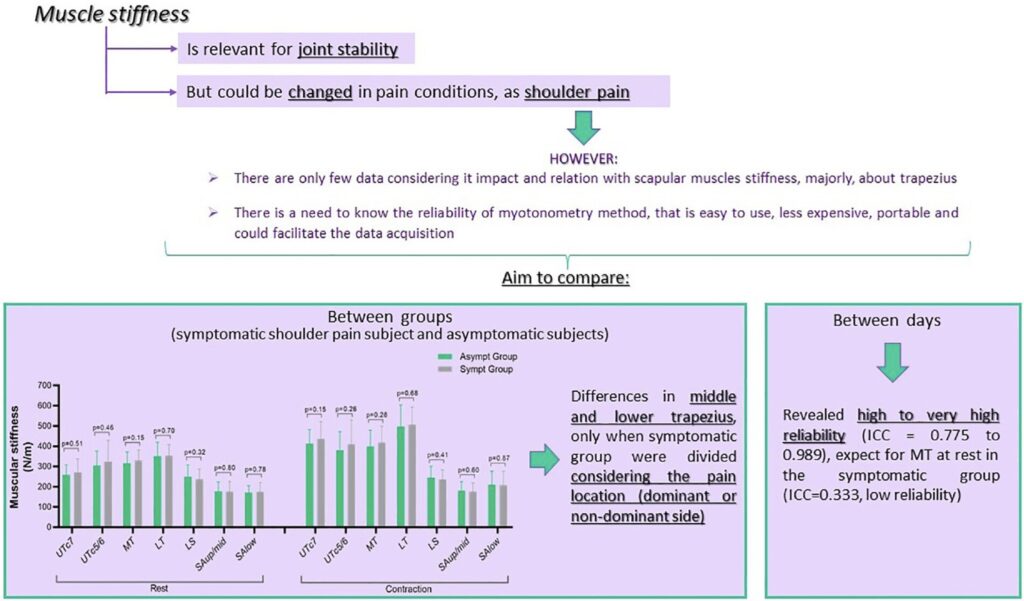Publications

Scapular muscle dynamic stiffness of asymptomatic subjects and subjects with chronic shoulder pain, at rest and isometric contraction conditions
Authors: Ana SC. Melo 1, 2, 3, 4, Barbara Montoia 5, Eduardo B. Cruz 6, 7, J. Paulo Vilas-Boas 3, 8, Andreia SP. Sousa 1
Affiliations:
- Centro de Investigaxcao em Reabilitaxcao (CIR), Escola Superior de Saude, Instituto Politecnico do Porto, Porto, Portugal
- Centro de Investigaxcao em Actividade Fisica, Saude e Lazer (CIAFEL), Faculdade de Desporto, Universidade do Porto, Porto, Portugal
- Laboratorio de Biomecanica do Porto (LABIOMEP), Universidade do Porto, Porto, Portugal
- Centro Interdisciplinar de Investigaxcao Aplicada em Saude (CIIAS), Escola Superior de Saude, Instituto Politecnico de Setubal, Setubal, Portugal
- Escola Superior de Saude, Politecnico do Porto, Porto, Portugal
- Departamento de Fisioterapia, Escola Superior de Saude, Instituto Politecnico de Setubal, Setubal, Portugal
- Centro de Investigaxcao Integrada em Saude (CHRC), Universidade Nova de Lisboa, Lisboa, Portugal
- Centro de Investigaxcao, Formaxcao, Inovaxcao e Intervenxcao em Desporto (CIFI2D), Faculdade de Desporto, Universidade do Porto, Porto, Portugal
Journal: Journal of Engineering in Medicine - February 2024, Proceedings of the Institution of Mechanical Engineers, Part H (DOI: 10.1177/09544119241228082)
-
Field & Applications:
- Medical
- Musculoskeletal disorder
- Reliability
Muscle stiffness had a crucial role in joint stability, particularly, at the shoulder complex. Although changes in upper trapezius muscle stiffness have been described for shoulder pain, contradictory findings have been obtained. Also, existing data regarding scapular muscles are, majorly, about trapezius. Myotonometry is a method used to assess stiffness; however, the reliability values of scapular muscle stiffness through this method have not been assessed in shoulder pain conditions.
The present study aims to compare scapular muscles’ stiffness (trapezius, serratus anterior, and levator scapulae) between subjects with and without chronic shoulder pain and to evaluate the related test-retest reliability.
Twenty-two symptomatic and twenty-two asymptomatic subjects participated in a cross-sectional study. The dynamic muscular stiffness of scapular muscles, at rest and during an isometric contraction, was measured bilaterally with myotonometry, in two moments. The differences in bilateral averaged values between symptomatic and asymptomatic subjects and the effect of the group (group presenting pain in the dominant or non-dominant side, and asymptomatic group) and of the limb (unilateral painful or asymptomatic limb, and bilateral asymptomatic limbs) were investigated. Test-retest intra-rater reliability was determined.
An effect of the group was observed at rest, for middle trapezius stiffness, and during contraction, for middle and lower trapezius stiffness. For middle trapezius, increased values were observed in the group presenting pain in non-dominant side comparing to both groups or to group presenting pain in dominant side. The intraclass correlation coefficient, majorly, ranged between 0.775 and 0.989.
Participants with pain in the non-dominant side presented an increased middle trapezius’ stiffness. Globally, high reliability was observed for scapular muscles dynamic stiffness.

Figure 0. Graphical abstract
Keywords: pain, myotonometry, trapezius, serratus anterior, levator scapulae, reliability
Between groups comparison only revealed differences when the symptomatic group was subdivided according to the shoulder pain’s side. In that case, the present study found that participants with non-dominant shoulder pain present increased MT stiffness, at rest and during contraction. The groups also presented differences in LT stiffness during contraction, but it was not possible to identify which were the groups that differed from each other. Scapular muscles dynamic stiffness can be assessed by myotonometry with high to very high test-retest intra-rater reliability, in asymptomatic or symptomatic subjects with unilateral chronic shoulder pain, except when measuring MT stiffness at rest in symptomatic participants.


